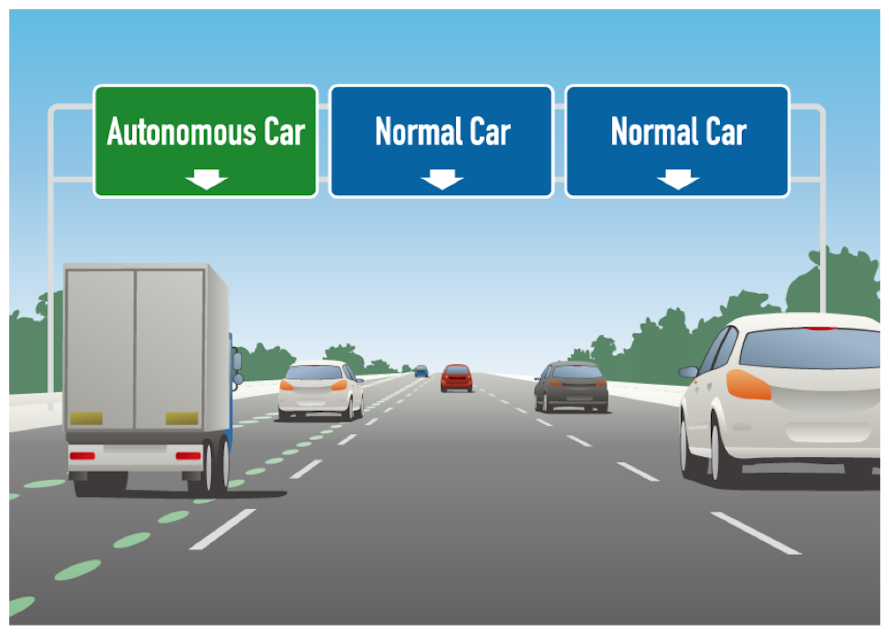Ban human drivers on I-5 from Seattle to Canada, firm says

How to solve traffic problems on I-5? What about banning humans from driving on it? And replacing them with robots?
A proposal to do just that is being discussed at a technology conference in Vancouver, B.C., that Washington Gov. Jay Inslee, B.C. Premier Christy Clark, Seattle Mayor Ed Murray, Microsoft founder Bill Gates and Microsoft CEO Satya Nadella were expected to attend on Tuesday.
The long-term vision of the proposal by Seattle's Madrona Venture Group is for the 150-mile ribbon of highway between Seattle and Vancouver, B.C., to be occupied only by driverless cars — except for quiet times at nights and weekends, when humans could reclaim the territory behind the wheel they'd lost to robots.
"Our proposal is not to ban humans at this point," Tom Alberg with Madrona Venture Group said. "But I think at some point, because they are so much more efficient and safer, that we should have time periods in heavy congested times when you would only have autonomous vehicles."
At first, the robot-cars would just get to share the HOV lanes on I-5.
Then the driverless cars would get their own lanes.
Then they'd get all the lanes.
The venture capital firm's proposal calls for, 10 to 15 years from now, allowing human drivers on I-5 only during "times when highways are not congested such as most of weekends and 8 p.m. to 4 a.m. on weekdays."
Driverless rush
Companies from Ford to Google are rushing to develop autonomous vehicles. Supposedly, the advanced cars will be able to reduce accidents and traffic by driving better than humans can. That said, an Ohio man died in May when letting his Tesla car do the driving. (Tesla has said it does not know whether a second fatal accident in China in September was caused by its car being in autopilot mode.)
Obama administration officials said on Monday the federal government, rather than states, should be in charge of regulating self-driving cars since the vehicles are essentially controlled by software, not people.
Transportation Secretary Anthony Foxx said states have historically set the rules for licensing drivers, but when the driver becomes a computer "we intend to occupy the field here."
He said states should stick to regulating human drivers and questions of liability.
Alberg said the I-5 proposal is not for the timid, but a driverless I-5 would boost business and tourism between the two high-tech cities.
He said the expense would compare favorably with developing high-speed rail in the corridor.
"Widespread adoption of autonomous vehicles is inevitable and will be here sooner than most observers expect," the Madrona report says.
Madrona Venture Group is part-owner of Bellevue-based Echodyne, which is developing radar systems to be used in driverless vehicles and other applications.
Resistance may be futile in the eyes of technology promoters, but critics don't buy it.
Fewer drivers, more driving
University of Washington civil engineering professor Don MacKenzie said social equity is the big blind spot for the driverless I-5 proposal. "You'd be shutting out a huge number of families who have older vehicles," MacKenzie said. "And these are probably the folks who, in all likelihood, have the fewest alternatives."
MacKenzie said, with 60 percent of cars in the United States lasting 15 years or more, in 15 years, "something like 1.5 million cars will be on the road in Washington that were manufactured this year or earlier."
MacKenzie said the biggest risk of of driverless cars is that they would lead to more driving.
"As someone who is from Vancouver and regularly travels between Seattle and Vancouver, I can tell you I would make that trip a lot more if my car could do the driving for me."
Once relaxing, working or even sleeping while traveling in a single-occupancy vehicle, people will adjust their lives and make longer and more trips by car.
MacKenzie said his group's studies show driving could increase by more than half.
Despite the benefits of quick-reacting driverless cars allowing more cars to zoom along any given stretch of roadway, the net effect could be more traffic and more pollution as people choose to be riders in their own cars instead of in more energy-efficient vehicles like buses or trains.
Additional reporting from the Associated Press.

